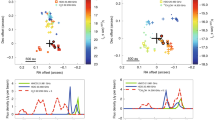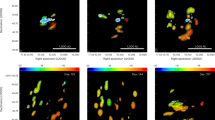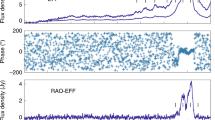Abstract
High-mass stars are thought to accumulate much of their mass via short, infrequent bursts of disk-aided accretion1,2. Such accretion events are rare and difficult to observe directly but are known to drive enhanced maser emission3,4,5,6. In this Letter we report high-resolution, multi-epoch methanol maser observations toward G358.93-0.03, which reveal an interesting phenomenon: the subluminal propagation of a thermal radiation ‘heatwave’ emanating from an accreting high-mass protostar. The extreme transformation of the maser emission implies a sudden intensification of thermal infrared radiation from within the inner (40-mas, 270-au) region. Subsequently, methanol masers trace the radial passage of thermal radiation through the environment at ≥4% of the speed of light. Such a high translocation rate contrasts with the ≤10 km s−1 physical gas motions of methanol masers typically observed using very-long-baseline interferometry (VLBI). The observed scenario can readily be attributed to an accretion event in the high-mass protostar G358.93-0.03-MM1. While being the third case in its class, G358.93-0.03-MM1 exhibits unique attributes hinting at a possible ‘zoo’ of accretion burst types. These results promote the advantages of maser observations in understanding high-mass-star formation, both through single-dish maser monitoring campaigns and via their international cooperation as VLBI arrays.
This is a preview of subscription content, access via your institution
Access options
Access Nature and 54 other Nature Portfolio journals
Get Nature+, our best-value online-access subscription
$29.99 / 30 days
cancel any time
Subscribe to this journal
Receive 12 digital issues and online access to articles
$119.00 per year
only $9.92 per issue
Buy this article
- Purchase on Springer Link
- Instant access to full article PDF
Prices may be subject to local taxes which are calculated during checkout



Similar content being viewed by others
Data availability
The data that support the plots within this paper and other findings of this study are available from the PAWSEY data archive (https://data.pawsey.org.au/public/?path=/VLBI/Archive/LBA/vx026) or from the corresponding author on reasonable request
References
Stamatellos, D., Whitworth, A. P. & Hubber, D. A. The importance of episodic accretion for low-mass star formation. Astrophys. J. 730, 32 (2011).
Meyer, D. M.-A., Vorobyov, E. I., Kuiper, R. & Kley, W. On the existence of accretion-driven bursts in massive star formation. Mon. Not. R. Astron. Soc. 464, L90–L94 (2017).
Hunter, T. R. et al. The extraordinary outburst in the massive protostellar system NGC 6334I-MM1: emergence of strong 6.7 GHz methanol masers. Astrophys. J. 854, 170 (2018).
MacLeod, G. C. et al. A masing event in NGC 6334I: contemporaneous flaring of hydroxyl, methanol, and water masers. Mon. Not. R. Astron. Soc. 478, 1077–1092 (2018).
Szymczak, M., Olech, M., Wolak, P., Gérard, E. & Bartkiewicz, A. Giant burst of methanol maser in S255IR-NIRS3. Astron. Astrophys. 617, A80 (2018).
Moscadelli, L. et al. Extended CH3OH maser flare excited by a bursting massive YSO. Astron. Astrophys. 600, L8 (2017).
Cragg, D. M., Sobolev, A. M. & Godfrey, P. D. Models of class II methanol masers based on improved molecular data. Mon. Not. R. Astron. Soc. 360, 533–545 (2005).
Breen, S. L., Ellingsen, S. P., Caswell, J. L. & Lewis, B. E. 12.2-GHz methanol masers towards 1.2-mm dust clumps: quantifying high-mass star formation evolutionary schemes. Mon. Not. R. Astron. Soc. 401, 2219–2244 (2010).
Bartkiewicz, A., Szymczak, M., van Langevelde, H. J., Richards, A. M. S. & Pihlström, Y. M. The diversity of methanol maser morphologies from VLBI observations. Astron. Astrophys. 502, 155–173 (2009).
Bartkiewicz, A., Szymczak, M. & Langevelde, H. J. European VLBI network imaging of 6.7 GHz methanol masers. Astron. Astrophys. 587, A104 (2016).
Ellingsen, S. P. Methanol masers: reliable tracers of the early stages of high-mass star formation. Astrophys. J. 638, 241–261 (2006).
Fujisawa, K. et al. Observations of the bursting activity of the 6.7 GHz methanol maser in G33.641-0.228. Publ. Astron. Soc. Jpn 66, 109 (2014).
Caswell, J. L. et al. The 6-GHz methanol multibeam maser catalogue—I. Galactic Centre region, longitudes 345° to 6°. Mon. Not. R. Astron. Soc. 404, 1029–1060 (2010).
Sugiyama, K., Saito, Y., Yonekura, Y. & Momose, M. Bursting activity of the 6.668-GHz CH3OH maser detected in G 358.93-00.03 using the Hitachi 32-m. Astron. Telegr. 12446 (2019).
Yonekura, Y. et al. The Hitachi and Takahagi 32 m radio telescopes: upgrade of the antennas from satellite communication to radio astronomy. Publ. Astron. Soc. Jpn 68, 74 (2016).
Brogan, C. L. et al. Sub-arcsecond (sub)millimeter imaging of the massive protocluster G358.93–0.03: discovery of 14 new methanol maser lines associated with a hot core. Astrophys. J. Lett. 881, L39 (2019).
Breen, S. L. et al. Discovery of six new class II methanol maser transitions, including the unambiguous detection of three torsionally excited lines toward G 358.931-0.030. Astrophys. J. 876, L25 (2019).
MacLeod, G. C. et al. Detection of new methanol maser transitions associated with G358.93-0.03. Mon. Not. R. Astron. Soc. 489, 3981–3989 (2019).
Molinari, S. et al. Hi-GAL, the Herschel infrared Galactic Plane Survey: photometric maps and compact source catalogues. First data release for the inner Milky Way: +68° ≥ l ≥ −70°. Astron. Astrophys. 591, A149 (2016).
Fischer, C. et al. FIFI-LS: the field-imaging far-infrared line spectrometer on SOFIA. J. Astron. Instrum. 7, 1840003–1840556 (2018).
Reid, M. J. et al. Trigonometric parallaxes of high mass star forming regions: the structure and kinematics of the Milky Way. Astrophys. J. 783, 130 (2014).
Bailer-Jones, C. A. L., Rybizki, J., Fouesneau, M., Mantelet, G. & Andrae, R. Estimating distance from parallaxes. IV. Distances to 1.33 billion stars in Gaia data release 2. Astron. J. 156, 58 (2018).
Garay, G., Mardones, D., Rodríguez, L. F., Caselli, P. & Bourke, T. L. Methanol and silicon monoxide observations toward bipolar outflows associated with class 0 objects. Astrophys. J. 567, 980–998 (2002).
Stecklum, B. et al. in Astrophysical Masers: Unlocking the Mysteries of the Universe (eds Tarchi, A., Reid, M. J. & Castangia, P.) 37–40 (IAU Symposium Vol. 336, Cambridge Univ. Press, 2018).
Audard, M. et al. in Protostars and Planets VI (eds Beuther, H., Klessen, R. S., Dullemond, C. P. & Henning, T.) 387–410 (Univ. Arizona Press, 2014).
Hosokawa, T., Yorke, H. W. & Omukai, K. Evolution of massive protostars via disk accretion. Astrophys. J. 721, 478–492 (2010).
Tan, J. C. in From Interstellar Clouds to Star-Forming Galaxies: Universal Processes? (eds Jablonka, P., André, P. & van der Tak, F.) 154–162 (IAU Symposium Vol. 315, Cambridge Univ. Press, 2016).
Caratti o Garatti, A. et al. Disk-mediated accretion burst in a high-mass young stellar object. Nat. Phys. 13, 276–279 (2017).
Hunter, T. R. et al. An extraordinary outburst in the massive protostellar system NGC6334I-MM1: quadrupling of the millimeter continuum. Astrophys. J. Lett. 837, L29 (2017).
Burns, R. A., Handa, T., Nagayama, T., Sunada, K. & Omodaka, T. H2O masers in a jet-driven bow shock: episodic ejection from a massive young stellar object. Mon. Not. R. Astron. Soc. 460, 283–290 (2016).
Deller, A. T., Tingay, S. J., Bailes, M. & West, C. DiFX: a software correlator for very long baseline interferometry using multiprocessor computing environments. Publ. Astron. Soc. Pac. 119, 318–336 (2007).
Acknowledgements
R.A.B. acknowledges support through the EACOA Fellowship from the East Asian Core Observatories Association. S.P.E., G.O. and L.H. acknowledge the support of the ARC Discovery Project (project number DP180101061). G.O. was supported by CAS LCWR grant 2018-XBQNXZ-B-021. A.M.S. was supported by the Foundation for the Advancement of Theoretical Physics and Mathematics “BASIS”. This work was supported by JSPS KAKENHI grant JP19K03921. T.H. is financially supported by the MEXT/JSPS KAKENHI grants 16K05293 and 17K05398. J.O.C. acknowledges support by the Italian Ministry of Foreign Affairs and International Cooperation (MAECI Grant Number ZA18GR02) and the South African Department of Science and Technology’s National Research Foundation (DST-NRF Grant Number 113121) as part of the ISARP RADIOSKY2020 Joint Research Scheme. This work was supported by the National Science Centre, Poland, through grant 2016/21/B/ST9/01455. The LBA is part of the Australia Telescope National Facility, which is funded by the Australian Government for operation as a National Facility managed by CSIRO. This work was supported by resources provided by the Pawsey Supercomputing Centre with funding from the Australian Government and the Government of Western Australia. The National Radio Astronomy Observatory is a facility of the National Science Foundation operated under cooperative agreement by Associated Universities, Inc.
Author information
Authors and Affiliations
Contributions
R.A.B. led the project as principal investigator for the observations, processed the data and authored the manuscript. K.S. and Y.Y. selected the target maser source. B.S., J.E., A.C.G. and A.M.S. provided theoretical interpretations of the data. G.O., S.P.E., L.H. and C.P. conducted the observations. All authors assisted in the interpretation of the results and contributed to the preparation of the manuscript.
Corresponding author
Ethics declarations
Competing interests
The authors declare no competing interests.
Additional information
Peer review information Nature Astronomy thanks Sandra Etoka and the other, anonymous, reviewer(s) for their contribution to the peer review of this work.
Publisher’s note Springer Nature remains neutral with regard to jurisdictional claims in published maps and institutional affiliations.
Source data
Source Data Fig. 1
Spectral line profile data.
Source Data Fig. 3
Velocities and positions of masers.
Rights and permissions
About this article
Cite this article
Burns, R.A., Sugiyama, K., Hirota, T. et al. A heatwave of accretion energy traced by masers in the G358-MM1 high-mass protostar. Nat Astron 4, 506–510 (2020). https://doi.org/10.1038/s41550-019-0989-3
Received:
Accepted:
Published:
Issue Date:
DOI: https://doi.org/10.1038/s41550-019-0989-3
This article is cited by
-
A Keplerian disk with a four-arm spiral birthing an episodically accreting high-mass protostar
Nature Astronomy (2023)
-
New maser species tracing spiral-arm accretion flows in a high-mass young stellar object
Nature Astronomy (2020)
-
Formation and Evolution of Disks Around Young Stellar Objects
Space Science Reviews (2020)



